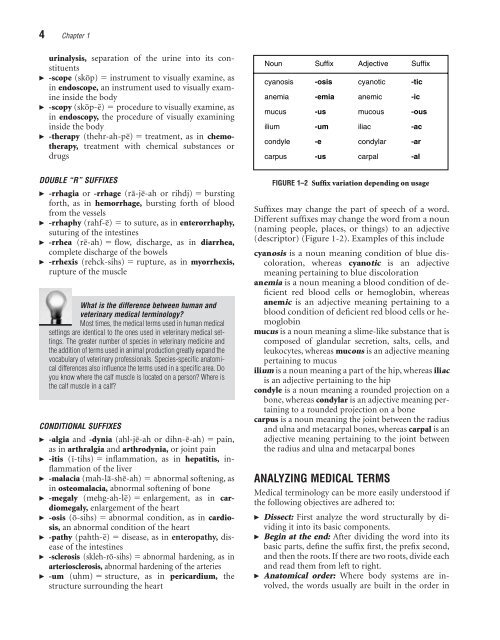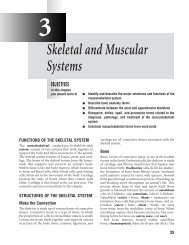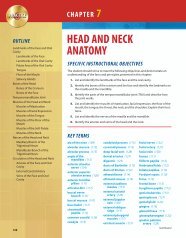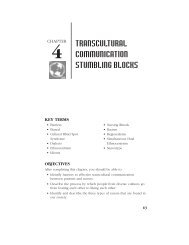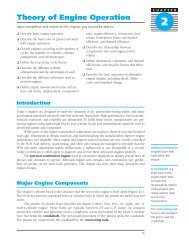Introduction to Medical Terminology - Delmar Learning - OPG Tools
Introduction to Medical Terminology - Delmar Learning - OPG Tools
Introduction to Medical Terminology - Delmar Learning - OPG Tools
Create successful ePaper yourself
Turn your PDF publications into a flip-book with our unique Google optimized e-Paper software.
4 Chapter 1<br />
urinalysis, separation of the urine in<strong>to</strong> its constituents<br />
-scope (skōp) instrument <strong>to</strong> visually examine, as<br />
in endoscope, an instrument used <strong>to</strong> visually examine<br />
inside the body<br />
-scopy (skōp-ē) procedure <strong>to</strong> visually examine, as<br />
in endoscopy, the procedure of visually examining<br />
inside the body<br />
-therapy (thehr-ah-pē) treatment, as in chemotherapy,<br />
treatment with chemical substances or<br />
drugs<br />
DOUBLE “R” SUFFIXES<br />
-rrhagia or -rrhage (rā-jē-ah or rihdj) bursting<br />
forth, as in hemorrhage, bursting forth of blood<br />
from the vessels<br />
-rrhaphy (rahf-ē) <strong>to</strong> suture, as in enterorrhaphy,<br />
suturing of the intestines<br />
-rrhea (rē-ah) flow, discharge, as in diarrhea,<br />
complete discharge of the bowels<br />
-rrhexis (rehck-sihs) rupture, as in myorrhexis,<br />
rupture of the muscle<br />
What is the difference between human and<br />
veterinary medical terminology?<br />
Most times, the medical terms used in human medical<br />
settings are identical <strong>to</strong> the ones used in veterinary medical settings.<br />
The greater number of species in veterinary medicine and<br />
the addition of terms used in animal production greatly expand the<br />
vocabulary of veterinary professionals. Species-specific ana<strong>to</strong>mical<br />
differences also influence the terms used in a specific area. Do<br />
you know where the calf muscle is located on a person? Where is<br />
the calf muscle in a calf?<br />
CONDITIONAL SUFFIXES<br />
-algia and -dynia (ahl-jē-ah or dihn-ē-ah) pain,<br />
as in arthralgia and arthrodynia, or joint pain<br />
-itis (ī-tihs) inflammation, as in hepatitis, inflammation<br />
of the liver<br />
-malacia (mah-lā-shē-ah) abnormal softening, as<br />
in osteomalacia, abnormal softening of bone<br />
-megaly (mehg-ah-lē) enlargement, as in cardiomegaly,<br />
enlargement of the heart<br />
-osis (ō-sihs) abnormal condition, as in cardiosis,<br />
an abnormal condition of the heart<br />
-pathy (pahth-ē) disease, as in enteropathy, disease<br />
of the intestines<br />
-sclerosis (skleh-rō-sihs) abnormal hardening, as in<br />
arteriosclerosis, abnormal hardening of the arteries<br />
-um (uhm) structure, as in pericardium, the<br />
structure surrounding the heart<br />
Noun<br />
cyanosis<br />
anemia<br />
mucus<br />
ilium<br />
condyle<br />
carpus<br />
Suffix<br />
-osis<br />
-emia<br />
-us<br />
-um<br />
-e<br />
-us<br />
Adjective<br />
cyanotic<br />
anemic<br />
mucous<br />
iliac<br />
condylar<br />
carpal<br />
Suffix<br />
-tic<br />
Suffixes may change the part of speech of a word.<br />
Different suffixes may change the word from a noun<br />
(naming people, places, or things) <strong>to</strong> an adjective<br />
(descrip<strong>to</strong>r) (Figure 1-2). Examples of this include<br />
cyanosis is a noun meaning condition of blue discoloration,<br />
whereas cyanotic is an adjective<br />
meaning pertaining <strong>to</strong> blue discoloration<br />
anemia is a noun meaning a blood condition of deficient<br />
red blood cells or hemoglobin, whereas<br />
anemic is an adjective meaning pertaining <strong>to</strong> a<br />
blood condition of deficient red blood cells or hemoglobin<br />
mucus is a noun meaning a slime-like substance that is<br />
composed of glandular secretion, salts, cells, and<br />
leukocytes, whereas mucous is an adjective meaning<br />
pertaining <strong>to</strong> mucus<br />
ilium is a noun meaning a part of the hip, whereas iliac<br />
is an adjective pertaining <strong>to</strong> the hip<br />
condyle is a noun meaning a rounded projection on a<br />
bone, whereas condylar is an adjective meaning pertaining<br />
<strong>to</strong> a rounded projection on a bone<br />
carpus is a noun meaning the joint between the radius<br />
and ulna and metacarpal bones, whereas carpal is an<br />
adjective meaning pertaining <strong>to</strong> the joint between<br />
the radius and ulna and metacarpal bones<br />
ANALYZING MEDICAL TERMS<br />
<strong>Medical</strong> terminology can be more easily unders<strong>to</strong>od if<br />
the following objectives are adhered <strong>to</strong>:<br />
Dissect: First analyze the word structurally by dividing<br />
it in<strong>to</strong> its basic components.<br />
Begin at the end: After dividing the word in<strong>to</strong> its<br />
basic parts, define the suffix first, the prefix second,<br />
and then the roots. If there are two roots, divide each<br />
and read them from left <strong>to</strong> right.<br />
Ana<strong>to</strong>mical order: Where body systems are involved,<br />
the words usually are built in the order in<br />
-ic<br />
-ous<br />
-ac<br />
-ar<br />
-al<br />
FIGURE 1–2 Suffix variation depending on usage


